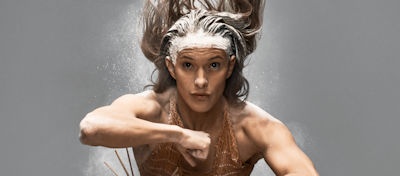Following a moving intercultural ceremony steeped in ritual, Kotahi, presented by Atamira under the new directorship of Jack Gray opens Tempo Dance Festival 2018. In 2 parts the first is Kotahi 1, a new interdisciplinary choreography by Louise Potiki Bryant (Ngāi Tahu and founding member of Atamira Dance). This dance begins and as our eyes circumnavigate a giant circle of black sand surrounding a small sand mound center stage, breath sounds seem to hang in the air. Light shafts on to a central seated figure, arms embracing the space with circular arm patterns. At this point, ever-changing dappled light marks the performer’s body and surrounding floor transforming the visual.
The stunning video projections and lighting weave their magic on the dancers, enhancing the movement vocabulary and cleverly providing a range of atmospheres to contemplate. These effects work in different ways throughout the piece, for example, geometric changing coloured patterns map the floor as the dancers weave across them. Projections create many stunning images, portraying and enhancing powerful moments throughout this work.
The physicality of six wāhine (female) deities/ancestors seems ritualistic and abstract at the same time, as we embrace the various qualities of the six in relation to their different powers of wind.
Rosie Tapsell depicts the powerful unruly north wind by performing a striking full-bodied solo punctuated with Maori movement such as wiri. Her movement is luscious and strong, wild and frenetic. The music and the dance complement each other at this point as they grow in intensity. The dance becomes more frenetic and at one point she strikes the sand circle with her foot spraying sand inwards, almost in defiance.
Two very strong matriarchal figures seem to spiritually hold the other four dancers within this sand circle as metaphor for the world. At several points, the Korari stick (flax stem) carves through space, up, down, spins right, left, as it slices the air with sharp precision. The movement is strong, ordered and traditional with clear associations to kapa haka. Tanu Richardson embodies being the mother of all five wāhine and the origin of the southerly wind walks powerfully and slowly on the sand circle as if to make her mark on the world, each step deliberate and firm on the sand.
Typical of Louise’s pieces are the addition and integration of symbolic objects. Woven flax, gourds, and giant fans are all made from natural fibers. The gourds feature in the powerful totem line up in which the women make shapes in a wide squat stance deeply rooted to the earth.
The changing relations of one versus three, unison, canon, one versus five, coupled with each section heralded by an exit or entrance provided an episodic framework.
Throughout the piece, a strong musical score composed by Paddy Free and Ariana Tikao inclusive of the very distinctive haunting sounds of taonga puoro played by Ariana captivates us. Rosie Tapsell, Tanu Richardson, Jasmin Canuel, Presley Ziogas, and Imogen Tapara command the space and our attention as they powerfully depict an expression of manu wahine through six atua wahine (female deities). The costume designs by Rona Ngahuia Osborne see strips of fabric swirl and wrap around the dancers as they move. The “creatives” named above collaborated together to create Onepū (Sand) a powerful statement conveyed through Maori contemporary dance, embodying the intrinsic spiritual power of women.
The piece builds to a climax in a striking image of dancers pouring the sand through their fingers letting it cascade to the floor. Followed by, the six dancers handfuls of sand sprinkling it liberally everywhere so that the stage transforms, being blanketed with a coat of black sand. As the dancers roll and move on the carpet of sand the different sounds they make captures my attention. This powerful wāhine dance concludes with a solo figure kneeling and bent forward, hair touching the sand, which I take to be a powerful reference to Papatūānuku (the mother earth).
The collective power of all contributors to this piece Onepū certainly honours a Kāi Tahu tradition about the story of the six female deities who control and release the principal winds of the world. I hope that more people will get the opportunity to embrace Onepū.
In comparison to the rich intercultural opening, the Q&A at the end of the show seems somewhat incomplete, too brief, with very little time to honour these artists in a culturally meaningful way. Since Onepū was such a collaborative work, why were the full cast including the dancers, not on stage at the end for the talk?
Copyright © in the review belongs to the reviewer





Comments